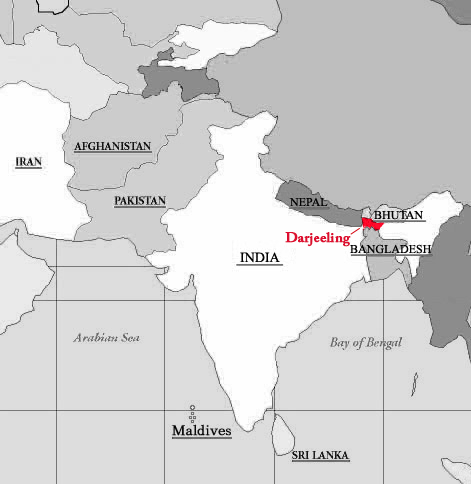Darjeeling First Flush. Veerinder, Founder, The Tao of Tea visits the oldest tea factory of the region to select his micro lot of the new season. The tea garden is at the edge of India and Nepal. Located in the Mirik valley of Darjeeling, the estate is nestled on the banks of the river Mechi, at an altitude ranging from 1770 mtrs to 2360 mtrs. Okayti tea estate is spread across 608 hectares. The garden was first planted in 1888 and has been owned for generations by the Kumbhat family. We are great friends with Antrishk, who heads the garden now. He keeps us high on the list of buyers given teh option to purchase the prized micro-lots. The estate is known locally as ‘Rangdoo’. The sound quality of the video is poor due to the high winds in the area.
Darjeeling
Tea Map – Darjeeling
Darjeeling is a renown tea growing region located in Northeastern India in the foothills of the Himalayan Mountains. It is home to around 86 estates, all planted along the region’s steep sloping hills at an elevation of around 6000 ft.
Over the years, tea from the region has become extremely sought after and the estates of Darjeeling have been bought up by a few primary families and some corporations. The popularity of the tea is due in part to its complex, sweet and fruity flavor that resembles that of a white muscat grape. Darjeeling primarily produces black teas. These teas have a pleasant brew that is neither too light nor too heavy. Another positive quality of Darjeeling tea is that most, if not all, is produced using orthodox (handmade) methods.
Consumers should be careful to go through trusted vendors when buying Darjeeling so to avoid imitations. Darjeeling produces about 10 million kilograms of tea per annum, and yet around 30 million kilograms of tea is sold worldwide every year and marketed as Darjeeling. Much of the counterfeit tea comes from outlying regions such as Nepal or the Kangra region of India.
Some reputable Darjeeling Gardens include Goomtee, Okayti, Ambootia, Gopaldhara, Jungpana, Margaret’s Hope, Castelton, Makaibari, Singell, Samabeong, and Selimbong.
